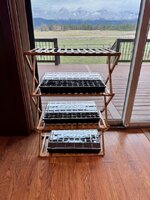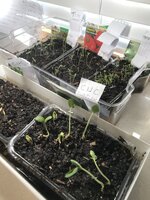- Messages
- 639
- Reactions
- 1,821
Got some seeds started. The rack is a little rickety, so nothing on the top shelf. Didn't want it to be top heavy.

I also picked up about two dozen strawberry plants from my parents. They needed to be thinned badly. I put them in the green house until we get some exterior raised beds built. The older my parents get, the less thinning and weeding they do. The garden still produces, but it's very overrun. We planted a new raised bed garden last year for them: three 3x40 beds, three or four cinderblocks high. By the end of this season, I predict that it will be just as overrun as their other garden, which is now mostly just an enormous berry thicket.

I also picked up about two dozen strawberry plants from my parents. They needed to be thinned badly. I put them in the green house until we get some exterior raised beds built. The older my parents get, the less thinning and weeding they do. The garden still produces, but it's very overrun. We planted a new raised bed garden last year for them: three 3x40 beds, three or four cinderblocks high. By the end of this season, I predict that it will be just as overrun as their other garden, which is now mostly just an enormous berry thicket.
Last Edited:












